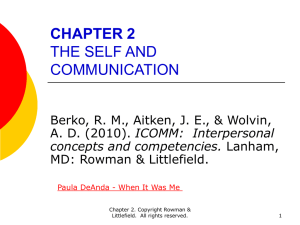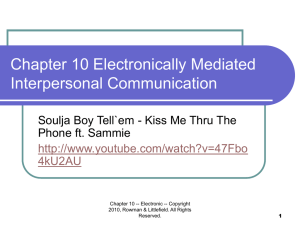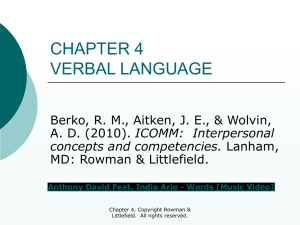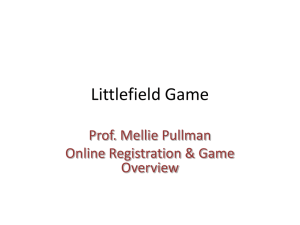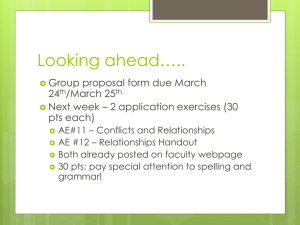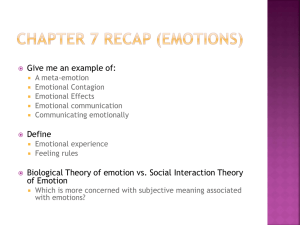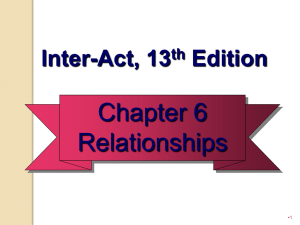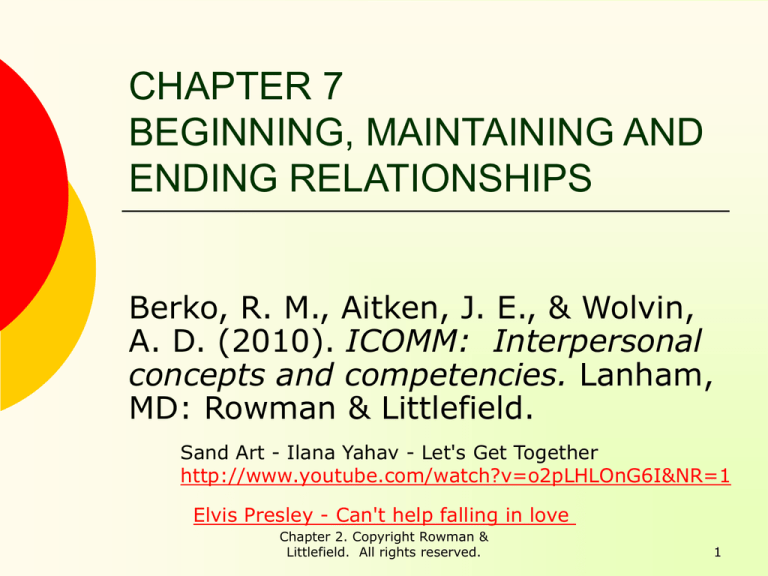
CHAPTER 7
BEGINNING, MAINTAINING AND
ENDING RELATIONSHIPS
Berko, R. M., Aitken, J. E., & Wolvin,
A. D. (2010). ICOMM: Interpersonal
concepts and competencies. Lanham,
MD: Rowman & Littlefield.
Sand Art - Ilana Yahav - Let's Get Together
http://www.youtube.com/watch?v=o2pLHLOnG6I&NR=1
Elvis Presley - Can't help falling in love
Chapter 2. Copyright Rowman &
Littlefield. All rights reserved.
1
RELATIONAL DEVELOPMENT:
BEGINNING, MAINTAINING AND ENDING
Relationships have a sequential
pattern:
an entry phase (beginning),
a personal phase (maintenance),
and
an exit phase (end).
Chapter 2. Copyright Rowman &
Littlefield. All rights reserved.
2
BEGINNING A RELATIONSHIP
Establishing a new relationship—one
that goes beyond a few minutes of
superficial chatter—is difficult.
Meeting strangers often brings out
our insecurities and our self
perceived flaws.
Chapter 2. Copyright Rowman &
Littlefield. All rights reserved.
3
BEGINNING A RELATIONSHIP
Attractiveness is your impression
of someone as appealing.
Proximity JUDY GARLAND: 'THE
BOY NEXT DOOR‘
Familiarity, a knowledge and
understanding of someone,
although it may breed contempt,
more often breeds liking.
Chapter 2. Copyright Rowman &
Littlefield. All rights reserved.
4
Cyberdating
Be realistic.
Eliminate traits you can’t live with.
Take your time.
Ask yourself if there are any
warning signs of potential abusive
or psychotic tendencies.
Be safe.
Be smart.
Chapter 2. Copyright Rowman &
Littlefield. All rights reserved.
5
Personal Ads
Gain attention with a catchy
headline.
Tell about yourself with necessary
information.
Get to the point.
Give an idea of what you're looking
for.
Chapter 2. Copyright Rowman &
Littlefield. All rights reserved.
6
Additional Choices
Fee-Based Introduction Services.
Speed Dating.
Matchmaking.
Relational Coaching.
Chapter 2. Copyright Rowman &
Littlefield. All rights reserved.
7
Steps for Initiating Relational
Communication
1.
2.
3.
4.
5.
Look for Approachability Cues.
Initiate a Conversation.
Find Topics to Talk About.
Talk About a Variety of Topics.
Share Plans for Future Interaction.
Chapter 2. Copyright Rowman &
Littlefield. All rights reserved.
8
How can you create a good
impression?
Be cooperative?
Be caring?
Be memorable?
Chapter 2. Copyright Rowman &
Littlefield. All rights reserved.
9
MAINTAINING A RELATIONSHIP
Relationships are two-sided. You
have control over only one of those
sides...yours.
Understand goals of both people.
Adapt to changes.
Follow the rules.
Pay attention to the process.
Work at success.
Chapter 2. Copyright Rowman &
Littlefield. All rights reserved.
10
Personal Ads Continued
Talk about your interests and
activities.
Offer a suggestion about how you
could spend time together.
Convey a sense of your personality.
Be honest!
Select the right picture.
Chapter 2. Copyright Rowman &
Littlefield. All rights reserved.
11
Achieving Your Objectives
Information is the basis for
effective relational decision-making.
Self-disclosure—is the process of
revealing a depth and breath of
your self so that you can begin,
maintain and develop a relationship.
Chapter 2. Copyright Rowman &
Littlefield. All rights reserved.
12
Self-disclosure
Is NOT an all-or-nothing
proposition.
Begins slowly with revealing
positive aspects of yourself.
Progresses—if at all—to greater
breadth, depth, and amount.
Chapter 2. Copyright Rowman &
Littlefield. All rights reserved.
13
Appropriate Self-Disclosure
Is the disclosure relevant to the
relationship?
How likely is the other person to treat the
disclosure with respect? Is the person a
gossip?
How constructive is the disclosure likely
to be for the relationship?
Can you communicate your disclosure
clearly and understandably?
Chapter 2. Copyright Rowman &
Littlefield. All rights reserved.
14
What is appropriate self-disclosure?
Self-disclosure is risky.
The primary fear associated with
self-disclosing is fear of rejection.
Chapter 2. Copyright Rowman &
Littlefield. All rights reserved.
15
Compliance gaining
An
active process to direct and
influence your communication
partner's behavior.
List of 64 compliance gaining strategies:
http://www.kkcomcon.com/KCGStrat.pdf
For a discussion on compliance gaining, see Canary, D.,
Cody, M., & Manusov, V. (2008). Interpersonal
communication: A goals-based approach (4th ed.).
Boston, MA: Bedford/St. Martins, Chapter 12.
Chapter 2. Copyright Rowman &
Littlefield. All rights reserved.
16
Relationships end for a variety of
reasons
Goals may be fulfilled and no new
goals established.
Goals may not be accomplished and
there may be little chance of
achieving them.
Chapter 2. Copyright Rowman &
Littlefield. All rights reserved.
17
Relationships end for a variety of
reasons
Goals may be fulfilled and no new
goals established.
Goals may not be accomplished and
there may be little chance of
achieving them.
Chapter 2. Copyright Rowman &
Littlefield. All rights reserved.
18
Relationships end for a variety of
reasons (continued)
The partners may continue to feel
lonely despite their relationship.
The patterns of interaction may be
too fixed, too inflexible, or too
boring.
Chapter 2. Copyright Rowman &
Littlefield. All rights reserved.
19
Relationships end for a variety of
reasons (continued)
The initial attractiveness may fade
and nothing new may replace it.
New relationships may appear more
attractive.
Chapter 2. Copyright Rowman &
Littlefield. All rights reserved.
20
Ending a Relationship
Terminating a relationship often
involves changes in other
relationships.
Confront the other person with your
desire—a direct relational
dissolution strategy.
See the other person less—indirect
relational dissolution strategy.
Chapter 2. Copyright Rowman &
Littlefield. All rights reserved.
21
Self-oriented or Other-oriented
Strategies
Self-orientation:
fait accompli ("I've decided this is over!")
withdrawal ("I'm going to be busy all next
week")
cost escalation ("If you want me to go
with you, you'll have to give up going out
on Fridays with your friends")
attributional conflict ("It's your fault,
jerk!").
Chapter 2. Copyright Rowman &
Littlefield. All rights reserved.
22
Other-oriented
state-of-the-relationship talk ("Where is
this relationship going?")
pseudo-descalation ("I think we should
see less of each other for a while"—when
no contact really is desired)
negotiated farewell ("Let's rationally
discuss how to end this without fighting")
fading away (seeing the other person less
and disclosing less)
Chapter 2. Copyright Rowman &
Littlefield. All rights reserved.
23
Most frequently used disengagement
Unilateral desire to exit (one person
wants out).
Coupled with an indirect strategy (the
person decreases contact, claims a desire
to reduce contact when no contact is
really the goal, or makes contact very
costly for the other person).
No attempts at repair (the pair say goodbye with no expectation for future
contact).
Chapter 2. Copyright Rowman &
Littlefield. All rights reserved.
24
Knapp Relationship Escalation
Model
Initiation Stage.
Intensifying Stage, self-disclosure
starts.
Integrating Stage, duo-based
terms.
Bonding Stage, a formal.
Differentiating Stage.
Chapter 2. Copyright Rowman &
Littlefield. All rights reserved.
25
Knapp Relationship Termination
Model
Differentiating Stage, differences.
Circumscribing Stage, less
communication.
Stagnating Stage, avoid.
Avoiding Stage, separating.
Terminating Stage.
Chapter 2. Copyright Rowman &
Littlefield. All rights reserved.
26
Application Learning Activities
Discuss with a partner or small group
or complete on your own outside
class.
Chapter 2. Copyright Rowman &
Littlefield. All rights reserved.
27
ROMANCE
What do you consider romantic?
How and why might people perceive
romance differently? Airport
Wedding Proposal
Chapter 2. Copyright Rowman &
Littlefield. All rights reserved.
28
MARRIAGE
What are your attitudes about marriage? You
may want to interview several people. Decide
what questions you will ask. You may want to ask
people of different ages, sexual orientations, or
ethnicities. What happens in marriage? What do
you think are the main correlates with a
successful marriage? Why do you think arranged
marriages work for many people? You may find
some interesting discussion prompts on the
Internet. Grover discusses What Is Marriage? Arranged Marriage Funny Commercial - Grover
discusses What Is Marriage?
Chapter 2. Copyright Rowman &
Littlefield. All rights reserved.
29
BREAKING UP
Is breaking up hard or
easy? Interview several friends on
the topic and see what they have to
say. Breaking Up Is Hard To Do "How To Break Up" Tales Of Mere
Existence - Breakin' Up Is Hard To
Do - Neil Sedaka - Walking Away Craig David
Chapter 2. Copyright Rowman &
Littlefield. All rights reserved.
30
RELATIONAL GOALS
Why do different people have
different goals for individual
relationships? Conduct an interview
asking people what they look for in
their relationships. You may find
some interesting discussion
prompts on the
Internet. Eurythmics - Sweet
Dreams 1983 - alicia keys - If I ain't
got you
Chapter 2. Copyright Rowman &
Littlefield. All rights reserved.
31
END
CHAPTER 7
BEGINNING, MAINTAINING AND
ENDING RELATIONSHIPS
Berko, R. M., Aitken, J. E., & Wolvin,
A. D. (2010). ICOMM: Interpersonal
concepts and competencies. Lanham,
MD: Rowman & Littlefield.
Landon Pigg - Falling In Love At A Coffee Shop
Chapter 2. Copyright Rowman &
Littlefield. All rights reserved.
32

